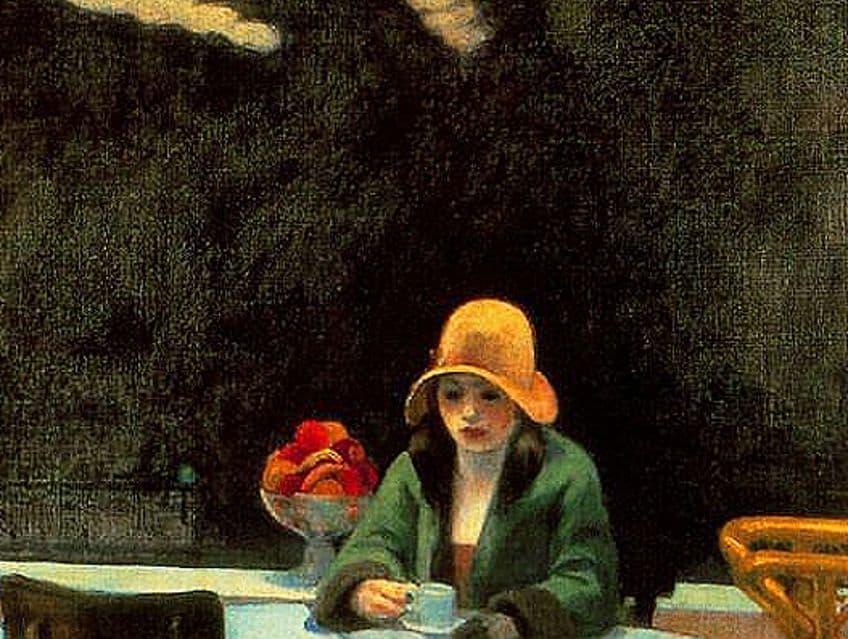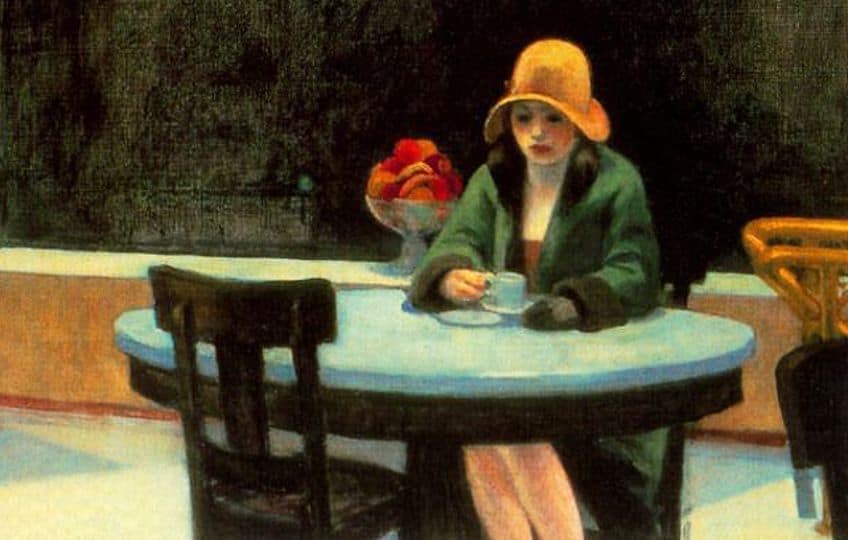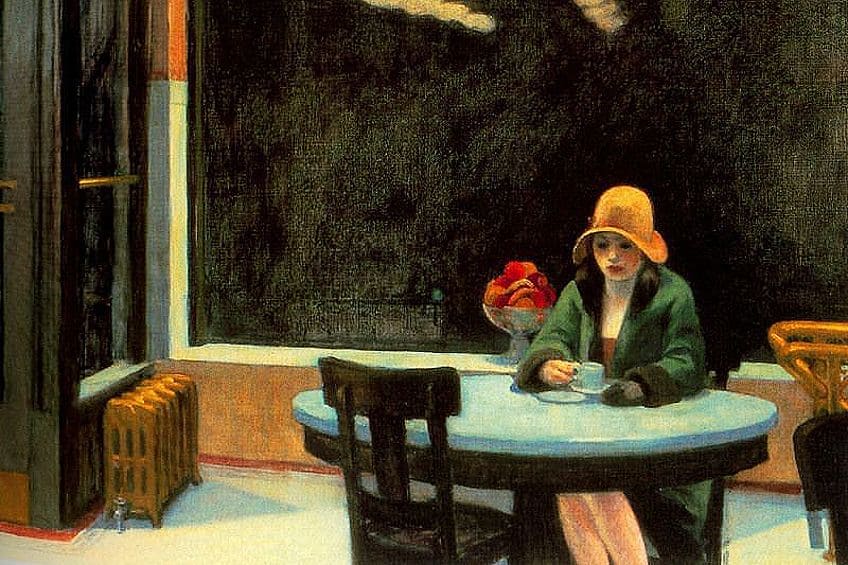“Automat” by Edward Hopper – A Detailed Painting Analysis
Automat, painted in 1927 by Edward Hopper, is an iconic representation of American Realism that captures the solitude and introspection of urban life in the early 20th century. This oil on canvas painting features a lone woman sitting in an empty automat, a type of self-service restaurant popular in the era. The composition masterfully uses light and shadow to convey a sense of isolation, with the woman’s downward gaze and the stark, empty surroundings emphasizing the theme of urban alienation. Hopper’s meticulous attention to detail and his ability to evoke emotion through seemingly mundane scenes make Automat a poignant commentary on the human condition in modern society. The painting remains a powerful testament to Hopper’s skill in depicting the psychological landscape of his time.
Key Takeaways
- Automat presents a solitary figure immersed in thought, showcasing Edward Hopper’s skill in depicting urban isolation.
- The painting is a snapshot of 1927 New York, reflecting broader themes of alienation in modern city life.
- Hopper’s work leaves a lasting impact through its meticulous composition and ability to evoke emotional introspection.
Historical Context
| Artist | Edward Hopper (1882 – 1967) |
| Date Created | 1927 |
| Medium | Oil on canvas |
| Genre | Realism, Urban scene |
| Period/Movement | American Realism |
| Dimensions (cm) | 71.4 x 91.4 |
| Series/Versions | Single version, no known series |
| Where Is It Housed? | Des Moines Art Center, Iowa, United States |
| What It Is Worth | Estimated value varies, considered highly significant |
Edward Hopper’s Automat is a captivating oil painting that encapsulates the essence of solitude within an urban environment. Created in 1927, the work is recognized for its realistic portrayal of a woman sitting alone in a well-lit automaton diner, a precursor to modern self-service eateries. The scene is devoid of any interaction, emphasizing a profound sense of isolation despite the public setting. The painting freezes a moment in time, offering an intimate glimpse into the subject’s private world shown through Hopper’s distinctive style.

Automat is a testament to Edward Hopper’s masterful ability to communicate narrative through the use of light, color, and composition. The diner, a space made for brief, impersonal encounters, ironically becomes a stage for a private moment of reflection. The woman’s contemplation, paired with the stark illumination in the painting, evokes a poignant sense of loneliness amid New York City’s bustling life.
Hopper’s work becomes a framework that invites viewers to contemplate the experience of modernity, resonating with audiences long after its inception.
Edward Hopper’s Life
Edward Hopper was born in 1882 in Upper Nyack, New York. He rooted his art in personal experience, subtly infusing it with his feelings and observations. In 1927, the year Automat was painted, Hopper was in his mid-40s and had been a part of the New York City art scene for several decades. His paintings, often described as melancholic and introspective, offer glimpses into 20th-century American life. Hopper’s upbringing in a small town and his life in Manhattan provided contrasting backdrops that influenced his focus on modern American realism.

Art Scene in 1920s New York
The 1920s New York art scene was a tumultuous mix of traditionalism and avant-garde. The city, particularly Manhattan, burgeoned as a cultural epicenter:
- Galleries and institutions: The presence of influential galleries like Rehn Galleries, where Automat was first displayed, played a critical role in nurturing artists.
- Influence of Europe: European modernism began to leave its mark on New York, with many American artists responding to or incorporating styles seen in the War-torn countries across the Atlantic.
- Jazz Age vibrancy: Fueled by post-war prosperity, New York embraced the Jazz Age, an era of radical social and cultural dynamics that also permeated the art world, influencing both the creation and reception of works.
Automat, a painting rich in mood and symbolism, was a quiet commentary amidst the noise of an energetic and shifting society.
Edward Hopper, through the lens of his personal vision, captured the isolation felt by many in the USA’s thriving urban landscapes.
Analysis of Automat
Edward Hopper’s Automat is a 1927 painting that stands as a significant example of his expert use of visual composition and color to convey themes of isolation and introspection.

Visual Composition
The subject of Automat is a young woman seated at a table, facing the viewer but gazing downward in a self-contained manner. Compositionally, Hopper places her almost at the center, with her surrounding environment playing a critical role in emphasizing her solitude.
The stark lines of the tables and chairs guide the viewer’s gaze towards her, underscoring her prominence.

Use of Color and Shadow
In Automat, Hopper utilizes a muted color palette, mainly composed of browns and greens, which creates a somber, reflective mood. The contrasting dark and light areas generate depth, with the brightly lit figure of the woman standing out against the darker background.
This has the effect of drawing attention to her pensive state.

Themes and Interpretations
One can observe a recurring theme of isolation. The separation between the young woman and the world outside is further stressed by the glass window that reflects the interior lights, producing a barrier between her and the outside world.
The content of Automat explores this solitude amidst the urban landscape, suggesting notions of anonymity and detachment.

Meaning of the Artwork
The artwork’s quality lies in its ability to stylistically and emotionally engage with the viewer. Hopper’s style, marked by realist depictions with a hint of narrative, prompts viewers to ponder the young woman’s story.
While the content hints at a reflective or lonely moment, the open-ended nature invites myriad interpretations about the meaning behind the woman’s solitude in the automat.

Legacy of Automat
Edward Hopper’s Automat is not only a distinguished piece from his body of work but has also become a significant icon in 20th-century art,navigating the themes of urban solitude and modernity with a strikingly quiet potency.
The painting’s impact extends beyond its initial presentation, influencing generations of visual artistry.
Influence on Modern Art
Automat has been considered a visual manifesto of modern solitude, reflecting the individual’s experience in an urbanized environment. Its influence is detectable in the later works across various art movements that dissect the multifaceted experiences of city life. Hopper’s use of space and light in this painting, as well as in others like Nighthawks, has been emulated and referenced by countless contemporary artists who seek to capture similar moments of introspection and urban isolation.
The subject matter aligns with a prevalent theme in Hopper’s oeuvre: the depiction of solitary figures and the nuanced exploration of their psychological states. This portrayal resonates with modern art’s inclination towards introspection and the subtle examination of human conditions, making “Automat” a precursor to numerous thematic investigations by later artists.

Moreover, paintings like Automat paved the way for realist art to hold its place within the broader narrative of 20th-century modern art, standing in contrast to other abstract and expressionist movements. Institutions such as the Whitney Museum of American Art have celebrated Hopper’s mastery, cementing his, and by extension, Automat, standing in American art history.
Inherent in Automat is a quiet yet powerful aesthetic solitude that invites reflection, a characteristic approach in Hopper’s work that has notably influenced the perception and creation of modern art. It remains a profoundly influential piece, inspiring both direct homage and a broader cultural engagement with the themes of urbanity and alienation that he so poignantly captured.
Edward Hopper’s Automat stands as a quintessential example of his ability to encapsulate the nuanced emotions of urban solitude and existential contemplation. Through its meticulous composition and evocative use of light and shadow, the painting delves into themes of isolation and introspection, resonating deeply with viewers even nearly a century after its creation. Hopper’s work transcends the mere depiction of a woman in a cafeteria, inviting us to explore the broader human experience and the silent, often unacknowledged moments of our daily lives. Automat not only highlights Hopper’s technical prowess but also his profound understanding of the human psyche, cementing its place as a significant piece in the canon of American Realism and in the broader narrative of art history.
Frequently Asked Questions
What Themes Are Depicted in Hopper’s Painting, Automat?
In Automat, Edward Hopper explores themes of urban solitude and social disconnection. The subject, a woman sitting alone in a café, emphasizes the feeling of isolation amid the crowd of a growing city.
Where Can One View the Original Automat Painting by Edward Hopper?
The original painting of Automat by Edward Hopper can be viewed at the Des Moines Art Center in Iowa. It remains a popular piece in their collection, attracting visitors who wish to experience Hopper’s iconic style firsthand.
How Does Automat Reflect the Sensibilities of the 1920s?
Automat reflects the sensibilities of the 1920s through its portrayal of modernity and changing social dynamics. The depiction of a single woman in public without accompaniment hints at the evolving roles of women and the alienation experienced in rapidly urbanizing areas during this era.
How Is Light and Shadow Used in Edward Hopper’s Automat?
Edward Hopper employs light and shadow in Automat to highlight the loneliness of the figure and to create a moody atmosphere. The stark contrast between the brightly lit face of the woman and the dark, empty space surrounding her further accentuates the theme of isolation.
Isabella studied at the University of Cape Town in South Africa and graduated with a Bachelor of Arts majoring in English Literature & Language and Psychology. Throughout her undergraduate years, she took Art History as an additional subject and absolutely loved it. Building on from her art history knowledge that began in high school, art has always been a particular area of fascination for her. From learning about artworks previously unknown to her, or sharpening her existing understanding of specific works, the ability to continue learning within this interesting sphere excites her greatly.
Her focal points of interest in art history encompass profiling specific artists and art movements, as it is these areas where she is able to really dig deep into the rich narrative of the art world. Additionally, she particularly enjoys exploring the different artistic styles of the 20th century, as well as the important impact that female artists have had on the development of art history.
Learn more about Isabella Meyer and the Art in Context Team.
Cite this Article
Isabella, Meyer, ““Automat” by Edward Hopper – A Detailed Painting Analysis.” Art in Context. June 3, 2024. URL: https://artincontext.org/automat-by-edward-hopper/
Meyer, I. (2024, 3 June). “Automat” by Edward Hopper – A Detailed Painting Analysis. Art in Context. https://artincontext.org/automat-by-edward-hopper/
Meyer, Isabella. ““Automat” by Edward Hopper – A Detailed Painting Analysis.” Art in Context, June 3, 2024. https://artincontext.org/automat-by-edward-hopper/.











